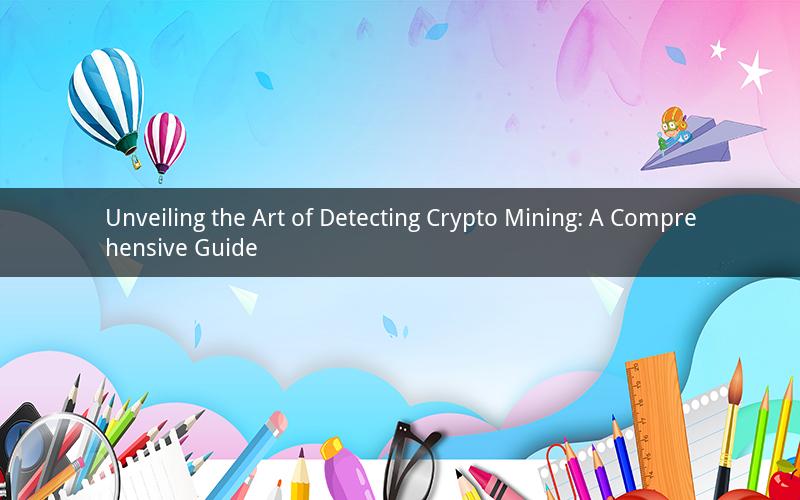
In the ever-evolving digital landscape, cryptocurrency mining has become a prevalent activity, attracting both legitimate participants and malicious actors. Detecting crypto mining on your computer or network is crucial for ensuring security and efficiency. This guide will delve into various methods and tools to help you identify and combat crypto mining activities effectively.
1. Understanding Crypto Mining
Before delving into detection techniques, it's essential to understand what crypto mining entails. Crypto mining is the process of validating and adding new transactions to a blockchain, thereby securing the network. Miners are rewarded with cryptocurrency for their computational efforts. However, some individuals and organizations engage in malicious crypto mining, which can lead to significant performance issues and security breaches.
2. Signs of Crypto Mining
Identifying crypto mining involves looking for certain signs and symptoms on your computer or network. Here are some common indicators:
a) Unusually High CPU Usage: Crypto mining requires significant computational power. If your computer's CPU usage is consistently high, it may be a sign of crypto mining activities.
b) Sudden Battery Drain: Crypto mining can consume a substantial amount of electricity, leading to a rapid drain on your device's battery, especially on laptops.
c) Slower Performance: A computer engaged in crypto mining may experience slower performance, including slower boot times, longer application load times, and overall reduced responsiveness.
d) Unexpected Pop-Ups and Redirects: Some crypto miners use malicious software to redirect users to mining-related websites or display intrusive pop-ups.
e) Increased Network Activity: If you notice a sudden surge in network traffic or unusual data usage patterns, it could indicate crypto mining activities.
3. Detecting Crypto Mining on Your Computer
To detect crypto mining on your computer, you can employ various methods:
a) Task Manager: Windows users can utilize the Task Manager to monitor CPU and memory usage. Look for processes that consume an excessive amount of resources.
b) Process Explorer: Process Explorer is a more advanced tool for Windows users. It provides detailed information about running processes, including CPU and memory usage.
c) CPU-Z: CPU-Z is a hardware monitoring tool that displays real-time data about your CPU, including clock speeds, temperatures, and power consumption.
d) Antivirus and Antimalware Software: Regularly scan your computer using reputable antivirus and antimalware software to detect and remove mining-related malware.
4. Detecting Crypto Mining on Your Network
Detecting crypto mining on your network involves monitoring traffic patterns and identifying unusual activity:
a) Network Monitoring Tools: Tools like Wireshark or tcpdump can help you analyze network traffic and identify suspicious activity.
b) Intrusion Detection Systems (IDS): IDS can detect and alert you to potential threats, including crypto mining activities.
c) Bandwidth Monitoring: Monitor your network's bandwidth usage to identify any unusual spikes that could indicate mining activities.
5. Preventing Crypto Mining
Preventing crypto mining involves taking several precautions:
a) Keep Your Software Updated: Regularly update your operating system, web browsers, and other software to patch vulnerabilities that could be exploited by miners.
b) Use Antivirus and Antimalware Software: Install and keep your antivirus and antimalware software up to date to protect against mining-related malware.
c) Disable Unnecessary Services: Disable unnecessary background services or processes that consume significant resources.
d) Use a Firewall: Employ a firewall to block unauthorized access to your computer or network.
f) Educate Employees: Educate employees about the risks of crypto mining and the importance of maintaining security best practices.
Questions and Answers:
1. Q: What are the common signs of crypto mining on a computer?
A: Common signs include unusually high CPU usage, sudden battery drain, slower performance, unexpected pop-ups and redirects, and increased network activity.
2. Q: How can I detect crypto mining on my computer?
A: You can use the Task Manager, Process Explorer, CPU-Z, antivirus and antimalware software, and network monitoring tools to detect crypto mining on your computer.
3. Q: What are the signs of crypto mining on a network?
A: Signs include sudden spikes in network traffic, unusual data usage patterns, and potential threats detected by intrusion detection systems.
4. Q: How can I prevent crypto mining on my computer or network?
A: To prevent crypto mining, keep your software updated, use antivirus and antimalware software, disable unnecessary services, use a firewall, and educate employees about security best practices.
5. Q: Are there any legal implications of detecting crypto mining on my network?
A: Detecting crypto mining on your network may have legal implications if the activities are deemed illegal or unauthorized. It is advisable to consult with legal professionals to understand the applicable laws and regulations in your jurisdiction.